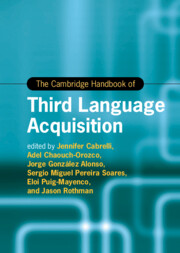Book contents
- The Cambridge Handbook of Third Language Acquisition
- Cambridge Handbooks in Language and Linguistics
- The Cambridge Handbook of Third Language Acquisition
- Copyright page
- Contents
- Figures
- Tables
- Contributors
- Introduction Multilingualism
- Part I Theoretical Approaches to L3/Ln
- Part II L3/Ln across Linguistic Domains
- Part III Becoming and Staying Multilingual at Different Ages
- Part IV L3/Ln in Action
- Part V L3/Ln and Cognition
- Part VI Research Methods in L3/Ln
- 25 Innovations and Challenges in Acquisition and Processing Methodologies for L3/Ln
- 26 Corpus Research
- 27 Case Study Research in Multilingual Contexts
- 28 Using Artificial Languages to Study Third Language Learning and Processing
- 29 Statistical Modeling in L3/Ln Acquisition
- Index
- References
27 - Case Study Research in Multilingual Contexts
from Part VI - Research Methods in L3/Ln
Published online by Cambridge University Press: 13 July 2023
- The Cambridge Handbook of Third Language Acquisition
- Cambridge Handbooks in Language and Linguistics
- The Cambridge Handbook of Third Language Acquisition
- Copyright page
- Contents
- Figures
- Tables
- Contributors
- Introduction Multilingualism
- Part I Theoretical Approaches to L3/Ln
- Part II L3/Ln across Linguistic Domains
- Part III Becoming and Staying Multilingual at Different Ages
- Part IV L3/Ln in Action
- Part V L3/Ln and Cognition
- Part VI Research Methods in L3/Ln
- 25 Innovations and Challenges in Acquisition and Processing Methodologies for L3/Ln
- 26 Corpus Research
- 27 Case Study Research in Multilingual Contexts
- 28 Using Artificial Languages to Study Third Language Learning and Processing
- 29 Statistical Modeling in L3/Ln Acquisition
- Index
- References
Summary
This chapter presents and discusses the methodological approach of case study in connection with research on third language acquisition and other areas of multilingualism and gives an overview of occurring case studies in these fields. After a brief introduction, the first section deals with the purpose of case study and characteristic features such as the real-life orientation and the holistic perspective, as well as the issue of generalizability. The second section discusses the nature and development of multilingual linguistic repertoires. Case studies here often cover large and complex repertoires. The overview of studies in the next section has a main focus on the third language acquisition area, but also deals with related thematic areas such as intercomprehension processes, polyglotism, linguistic autobiographies, and studies visualizing the multilingual subject.
- Type
- Chapter
- Information
- The Cambridge Handbook of Third Language Acquisition , pp. 696 - 723Publisher: Cambridge University PressPrint publication year: 2023



